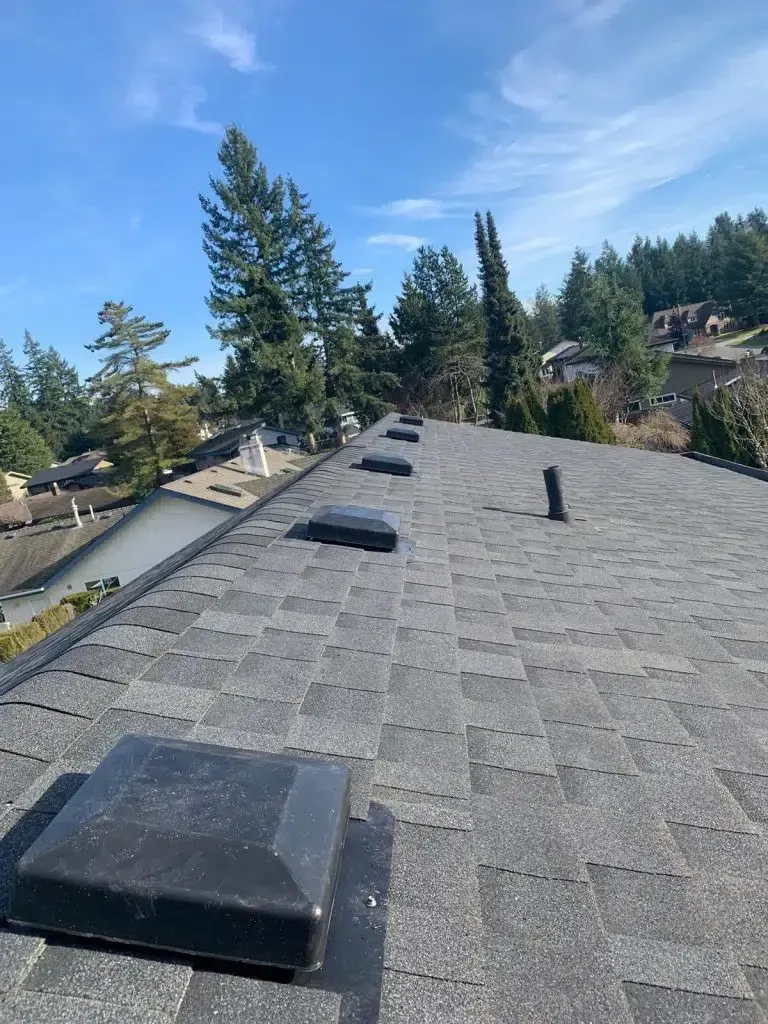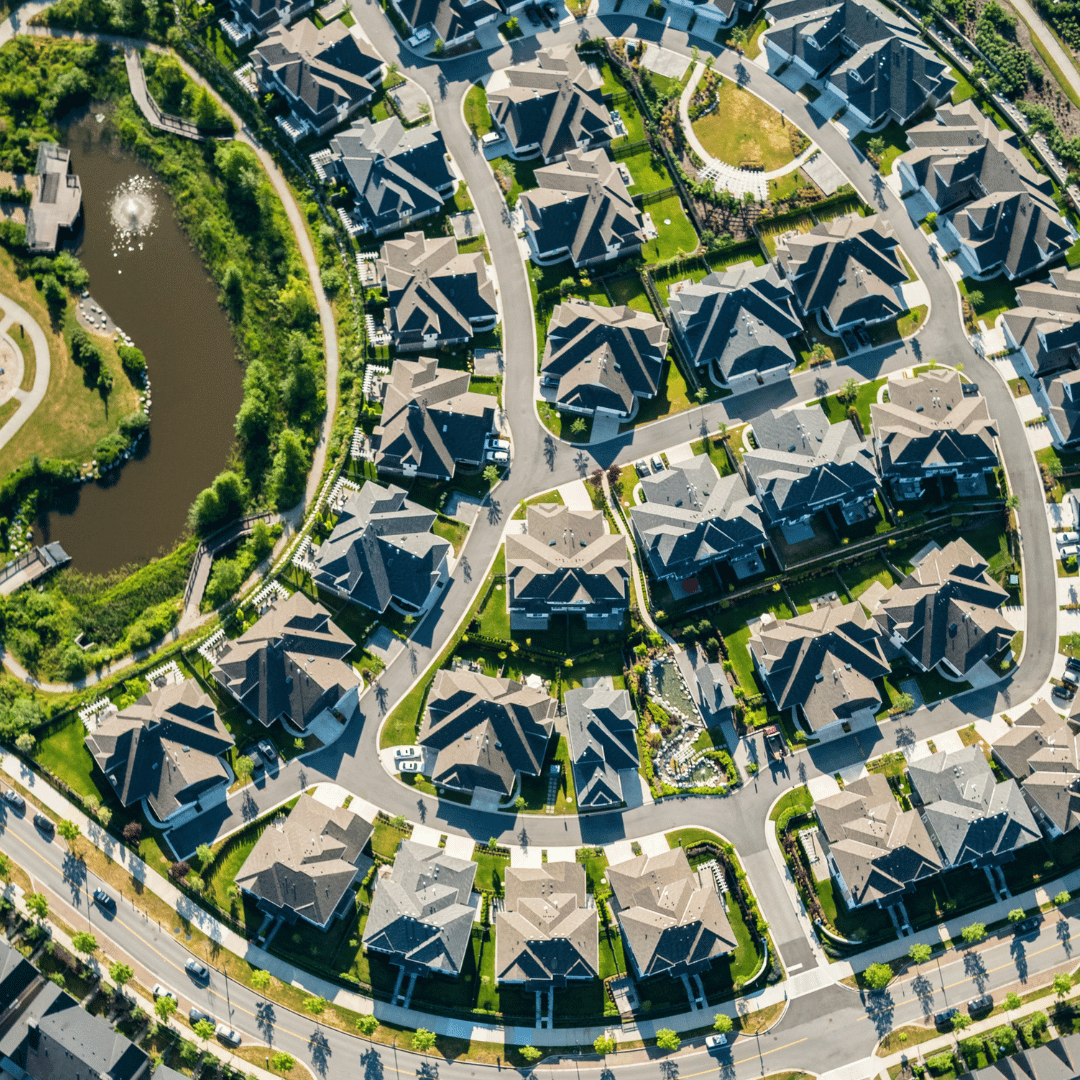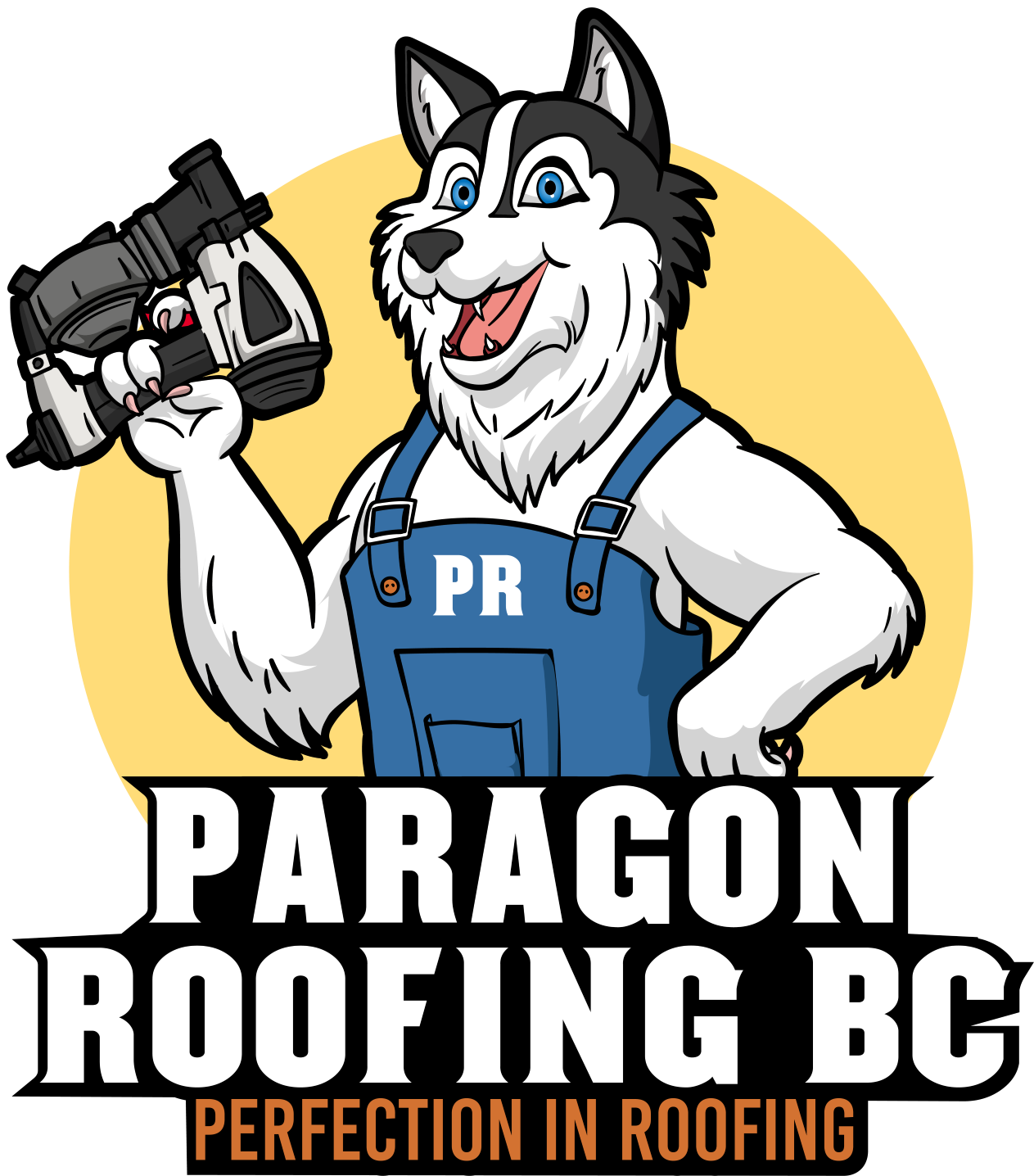Need guidance for your own project? Our professional Burnaby roofing services are just a click away.
The Burnaby Roofing Puzzle
Burnaby is no sleepy suburb; it’s a coastal-mountain crossroads that gets pelted by Pacific rain systems in November, baked under sudden August heat domes, and rattled—every so often—by rumblings from the Cascadia subduction zone. Annual precipitation nudges past 2,300 mm, with the wettest month (November) dumping roughly 259 mm in just thirty days. That cocktail of damp, wind, and seismic jitters means choosing the wrong roof isn’t an “oops” you fix next weekend—it’s a decade-long headache. So, which material stays watertight, shrugs off moss, and still makes your Tudor on Sussex Avenue look like it belongs? Let’s dissect asphalt shingles, metal panels, and tile one layer at a time.
Asphalt Shingles: The Familiar Workhorse
1. Weather Performance
Asphalt shingles thrive when installed with proper underlayment and ridge-vent combinations. The granular surface disperses driving rain, and modern SBS-modified variants stay flexible during Burnaby’s freeze-thaw snaps. Yet that very granule layer erodes fastest in our high-precipitation belt; I routinely vacuum gutters stuffed with shingle grit after 10 years on Capitol Hill.
2. Lifecycle & Cost
A mid-grade architectural shingle hits the sweet spot for most clients: materials at $5–$6 per ft², installed cost around $9 per ft². Expect 18–23 years before the first tell-tale curling. Budget friendly? Absolutely. But remember: replacement every two decades means three tear-offs over a 60-year ownership period—labour, landfill fees, and fresh permits each time.
3. Maintenance
Annual moss treatments are non-negotiable in shaded South Slope pockets. Pair that with twice-yearly gutter clean-outs and you’ll postpone premature edges. Ignore it and moisture will wick under the tabs faster than you can say “delamination.”
4. Aesthetic Fit
Burnaby’s post-war neighbourhoods—think Brentwood ranchers and Garden Village split-levels—wear asphalt naturally. Colour palettes have evolved: russet tones mimic cedar, charcoal compliments black aluminum fascia, and algae-resistant lines prevent the infamous green streak down Beaconsfield Avenue.
Verdict: Asphalt remains the “default” because it balances upfront affordability with solid (if finite) resilience. Homeowners flipping within ten years usually stop reading here.
Metal Roofing: The 50-Year Storm Tamer
1. Weather Performance
Standing seam or interlocking metal panels form a continuous shell. Rainwater sluices off like it’s late for a SkyTrain, snow hesitates then slides, and hurricane-style gusts find no purchase at the seams. The baked-on Kynar coatings shrug off UV fade. In 2019’s surprise windstorm I replaced exactly zero panels on our metal installs; asphalt neighbours, however, peppered my yard like flying poker chips.
2. Lifecycle & Cost
Installed price sits between $14–$19 per ft² depending on gauge (26- vs 24-gauge) and complexity. That’s sticker shock for some, until you amortize across 50–70 years. One roof replaces two or three asphalt cycles, saving two landfill runs and one midlife re-sheathing. In other words: pay Tesla today, skip the Civic tomorrow.
3. Energy & Noise Myths
Metal reflects radiant heat, dropping attic temps up to 25 °C during August highs—an unsung perk when BC Hydro bills climb. As for the “it’ll sound like a tin drum” worry: underlayment, vented nail-base, and attic insulation quell storm noise to near-asphalt levels; you’ll hear the rain on your skylight before you hear it on your roof.
4. Maintenance
Moss? Doesn’t even bother. Annual inspection of gaskets and snow-guards, plus a hose rinse if seagull art gets excessive, is plenty.
5. Aesthetic Fit
Modern Burnaby is a mosaic: glass-box infills near Deer Lake, 1990s stuccos in The Crest, mid-century bungalows everywhere else. Matte charcoal panels lend a West Coast-contemporary vibe without clashing; copper-tone accents add warmth to cedar trim.
Verdict: For homeowners intent on planting roots—and reducing lifetime carbon footprint—metal is the pragmatic long-game.
Tile Roofing: The Mediterranean Wild-Card
1. Weather Performance
Concrete or clay tile laughs at rain and shrugs off UV, but weight is the elephant on the rafters. A typical concrete tile roof exceeds 10 lbs per ft²—triple asphalt, double metal. Before I sign a tile contract in Burnaby, I order a structural engineer’s stamp and sometimes bolster rafters. On the upside, tile’s thermal mass moderates attic temperature swings.
2. Lifecycle & Cost
Material plus installation hovers at $18–$25 per ft². Tiles themselves can last 75 years, but underlayment swap at the 40-year mark is mandatory, essentially re-roofing beneath the tiles.
3. Maintenance
Individual tiles may crack from freeze-thaw or branch impact. Replacing one requires surgical care—stand on foam pads, unhook the broken piece, slide in a new tile without domino-ing its neighbours. Debris tends to lodge between water channels, making annual compressed-air cleaning essential.
4. Aesthetic Fit
Spanish-mission clay looks majestic but can feel ostentatious on a Woodlands townhouse. Concrete “slate” profiles blend better: dark greys harmonize with Burnaby Mountain’s basalt backdrop.
Verdict: Choose tile when the home’s architecture demands it—Mediterranean villas, heritage restorations—and your budget and framing can shoulder the load.
Permit & Code Realities
Burnaby’s Building Bylaw demands a permit for any roof replacement that alters structural elements; even straight-off swaps often trigger paperwork under the Home Improvement Permits program. As of July 1, 2024, all residential permits must meet the bylaw “in its entirety,” nixing grandfathered mixing-and-matching loopholes. Translation: If your 1968 rafters don’t meet current snow-load specs, that dream tile roof might remain a Pinterest fantasy unless you reinforce the skeleton. Metal and asphalt usually pass without beefing up the frame, keeping permit fees and timelines civil.
Cost-of-Ownership Snapshot (30-Year Horizon)
| Material | Install Cost on 2,000 ft² | Expected Re-roof Cycles (30 yrs) | Total Material/Labour Spend | Estimated Maintenance | Combined Outlay |
|---|---|---|---|---|---|
| Asphalt | ≈ $18,000 | 1.5 | ≈ $27,000 | $2,500 | ≈ $29,500 |
| Metal | ≈ $32,000 | 0 | ≈ $32,000 | $1,200 | ≈ $33,200 |
| Tile | ≈ $40,000 | 0 (underlayment @ yr 20) | ≈ $44,000 | $3,000 | ≈ $47,000 |
Numbers include 5 % annual inflation baked into future cycles; disposal and permit fees folded in.
Environmental Footprint
- Asphalt: Petroleum-based, recyclability still niche. Three tear-offs equal ~9 metric tonnes of waste.
- Metal: 25–95 % recycled content and 100 % recyclable at end-of-life. Solar-panel-ready out of the box.
- Tile: Concrete or natural clay, energy-intensive to fire but inert thereafter; disposal often repurposed as aggregate.
If you’re chasing a low-carbon build and can stomach the upfront cheque, metal edges ahead.
Decision Matrix (Quick-Fire)
| Question | Choose Asphalt If… | Choose Metal If… | Choose Tile If… |
|---|---|---|---|
| Staying how long? | < 10 yrs | > 20 yrs | > 30 yrs |
| Need fastest install? | Yes | Moderate | No |
| Worried about weight? | Low | Lowest | High |
| Want modern curb appeal? | Neutral | Strong | Selective |
| Budget flexibility? | Tight | Medium | High |
| Moss nightmare yard? | Expect maintenance | Minimal moss | Channels collect debris |
| Sustainability goal? | Lowest | Highest | Moderate |
Story from the Field
Last autumn, I replaced a 1997 three-tab shingle roof on Royal Oak Avenue. The homeowner had battled moss colonies so thick they needed a putty knife. We quoted asphalt and metal; metal won. Three months later the atmospheric river of December 2024 hit—140 mm in 48 hours. Gutters overflowed but the standing seam stood proud, bone-dry attic, zero uplift. The neighbour’s asphalt (installed the same month) suffered a half-dozen lifted tabs and a minor leak over the living room. Case study complete.
Frequently Sidestepped Questions
Does metal attract lightning?
Lightning targets the highest conductive path; roofing material plays a bit part. If you’re the tallest tree in the field—penthouse on Kingsway—install a proper lightning rod and sleep easy.
Will tile send snow avalanching onto my walkway?
Burnaby’s snow loads are light compared to Whistler, but a well-placed snow-stop above entryways, regardless of material, is best practice. Tile’s texture naturally slows the slide compared to slick metal.
Can I layer new shingles over the old ones?
Technically permitted once, but we refuse. Extra weight, hidden rot, voided warranties—false savings that boomerang as insurance headaches.
Final Recommendations—Straight from the Ridge Cap
- Do the math beyond day-one. If you plan to raise a family through graduation in the same house, metal usually wins on lifetime dollars and headache-free Sundays.
- Audit your attic framing before fantasizing about tile. Love the Mediterranean look? Reinforce first, install later.
- Think neighbourhood cohesion. In Suncrest’s rancher rows, a gleaming red barrel-tile roof may scream “look at me!”—not always in a good way.
- Respect the permit queue. Burnaby’s digital “My Permits Portal” streamlines paperwork, but booking inspections still takes weeks in peak season.
- Plan for climate extremes, not averages. November downpours test seams; August UV cooks asphalt; a rogue windstorm bullies poor fastenings. Install like the worst case is the baseline.
Closing Thoughts from Your Rooftop Ally
Roofs are more than shingles, panels, or tiles: they’re insurance policies against the Pacific’s mood swings. Asphalt keeps wallets happy today; metal rewards patience; tile indulges architectural passion. Whichever path you choose, pair quality materials with meticulous installation, and Burnaby’s rain—be it a gentle mist or a sideways deluge—will remain a distant percussion on the other side of your ceiling.
I’ll be on the next roof down the block, cordless impact in hand, should you need a second set of eyes. Until then, keep looking up—and make sure what’s above you is built to last.



